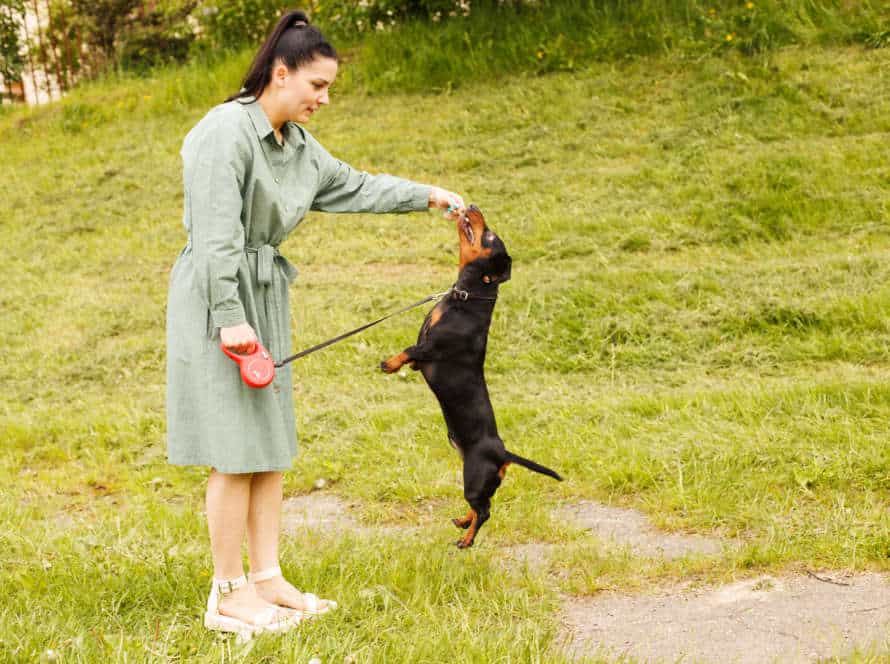Understanding the Function of Barking in Canine Communication
Dogs bark to communicate. It has many uses. Here are some common reasons:
- Warning or alert call: Barking can alert owners to danger or intruders.
- Attention-seeking: Dogs bark to get attention from owners or to ask for food, water or playtime.
- Fear or anxiety: When scared or anxious, dogs may bark. This can be due to loud noises or being away from their owners.
- Playfulness: Dogs may bark when playing with other dogs or humans.
- Territoriality: Barking marks their territory and warns other animals away.
Figuring out why your dog barks can help you understand them better, and help you both communicate more easily.
The Basics of Barking for Canine Communication
Dogs bark for communication. Knowing why and how they do it is key for forming a strong bond with them. Barking can mean many things – from aggression to joy. This article will detail the purpose of barking in canine communication.
Why do dogs bark?
Dogs bark to communicate their needs. There are various reasons why they do so. Let’s see a few of them!
- Alert Barking: They bark to alert their owners about any perceived dangers, like a stranger or loud noise.
- Demand Barking: They bark when they want something, like food, attention or playtime.
- Anxiety/Fear Barking: Dogs bark when they are scared or anxious. Seeking comfort or warning others is their way of communicating.
- Playful Barking: When they’re excited and want to play, dogs bark too.
Understanding why dogs bark helps owners interpret their needs and build a strong bond. A pro tip: Training consistently can help reduce excessive barking and ensure your pup communicates with you effectively.
What do different types of barking mean?
Barking is a dog’s way of speaking! Let’s take a look at different types of barking and their meanings.
Warning barks are loud and repetitive, with aggressive body language.
Play barks on the other hand, are higher-pitched, shorter and come with tail wagging or jumping.
Attention-seeking barks are insistent and persistent and usually stop once you’ve paid attention.
Lastly, dogs suffering from separation anxiety may bark excessively when left alone, accompanied by destructive behavior. If your pooch displays this, consider chatting with a vet or animal behaviorist.
How do dogs use barking to communicate with humans and other dogs?
Dogs bark to communicate with humans and other dogs. It can be for different reasons:
- Alarm – when they sense something unusual or a possible threat.
- Aggression – when they feel threatened or protective.
- Play – when they want someone to join in the fun.
- Anxiety – when they’re left alone or in uncomfortable situations.
Knowing why dogs bark helps owners better understand their pet’s behaviour and needs.
Understanding the Context of Barking
Barking is a pup’s way of talking. It can mean many things – from warning off other dogs to inviting them to play. But, it’s not just the sound that matters – the context is equally important. Let’s explore the different contexts where a dog may bark.
How does a dog’s environment impact barking behavior?
A dog’s environment has a major effect on their barking habits. Dogs bark to express themselves and different environments can bring out various barking reactions.
For example, dogs living in built-up areas may bark more often due to the noise and more people coming and going. Meanwhile, dogs in rural areas may bark less but can still be triggered by other animals, e.g. cows or horses.
Moreover, homes with multiple dogs or young children may cause more barking because of the higher energy and activity. Owners can reduce barking with a tranquil and controlled home environment for their dogs. Doing obedience training and giving enough exercise also helps to decrease barking.
Understanding why dogs bark can assist owners to converse better with their canine friends, set clear limits and routines, and provide a great life for both pets and owners.
What role does a dog’s breed play in barking tendencies?
A dog’s breed has a major impact on their barking. Different breeds are bred for different roles, such as hunting, herding, guarding, or being a companion. For example, guard dog breeds like German Shepherds, Doberman Pinschers, or Boxers have a natural talent for barking loudly and continuously to warn their owners and scare off intruders. Hunting breeds like Beagles or coonhounds, however, are bred to bark in a certain way to follow game and talk to their hunting companions.
It is important to recognize that a dog’s upbringing, socialization, and training can also shape their barking behavior, despite their breed. It is essential to know the reason for barking and the purpose of barking in canine communication. This will help to tell when it is necessary or too much, and how to stop or change any undesired barking.
How do dogs use barking in social situations?
Barking is an important way for dogs to talk to their owners and other pooches in different social situations. It’s a main method of showing their feelings, wants, and aims. Let’s look at some common times when dogs bark in social settings:
- Telling their owners about possible dangers: Dogs may bark if they notice potential dangers, to caution their owners to take steps or have a look.
- Welcoming their owner: To express their joy and love, dogs usually bark when their owner comes home.
- Defending their territory: Dogs bark to show they’re there and to tell trespassers to stay away.
- Expressing unease or fear: If a pup is in a novel environment or meets someone new, they may bark to show they’re scared or uneasy.
Knowing the context and aim of your dog’s bark can help you communicate better with them and answer their needs correctly.
Managing Excessive Barking
Canines are social animals. Barking is a key way for them to communicate. It can show emotions and alert family to potential dangers. But too much barking can be a problem. To manage this, we need to understand the science behind it. In this section, we’ll explore the science of barking and how to manage excessive barking.
How to train a dog to reduce excessive barking
Train your pup to cut down on too much yapping. Comprehend the function of barking in doggy dialogue. Here are some tips:
- Find the source of barking. Dogs bark for various reasons, like dullness, fretfulness, fright, enthusiasm, or to grab attention.
- Teach your pet to obey a “quiet” command. Use a training technique wherein you say “quiet” when your pet barks and reward them with a treat when they stop barking.
- Reward when they’re quiet and cool. Give them praises and treats when they’re not barking, like when visitors come, during meals, or during playtime.
- Present suitable exercise and mental stimulation. Give your dog enough time to do exercise and play, provide chew toys, and brainteasers that can help to activate their minds and decrease boredom.
Pro tip: Remain patient and consistent in your training. Keep in mind that training your pooch to reduce outrageous barking takes time, effort, and determination.
Techniques for addressing anxiety-related barking
Excessive barking is a symptom of anxiety in dogs, and can be tough to manage. Knowing how barking works in doggy communication is vital to controlling it. Here are some tips:
- Identify the cause: Work out which things make your pup anxious and make them bark.
- Don’t reward barking: Don’t give attention or treats when your pup barks.
- More exercise: Increase your dog’s exercise to help ease their anxiety and lessen the barking.
- Training: Teach your pup commands like “quiet” to lessen their anxious barking.
- Medication: If needed, vets can prescribe meds that help with anxiety and reduce the barking.
Remember, it takes time and patience to address anxious barking in dogs. Keeping to the same training and not reinforcing bad behavior is the key to success.
When to seek professional help for barking issues
Barking is a typical doggy way of communicating. But too much barking can be a problem. Some pooches bark more than others due to their breed, age, or character. It’s important to recognize when barking is becoming an issue and when to get help from an expert.
These are signs you should call in a professional trainer or behaviorist:
- Your pup barks at the wrong moments, like through the night or in the early morning.
- Your canine barks a lot when they’re left alone.
- When barking, your pup shows aggression or fear.
- Complaints from other people or fights with your neighbors due to your pup’s barking.
A pro trainer or behaviorist can help you understand why your pup barks and make a personal plan to manage the issue.
Tip: Before asking for help, try to find out what’s causing your pup’s excessive barking, such as boredom, anxiety, or lack of exercise. Then, address it accordingly.
Conclusion and Takeaways of Barking in Canine Communication
To wrap things up, barking is a significant way for canines to talk. It helps them to share their feelings and also to warn other canines of any potential risks. It’s an instinctive type of communication and one of the first things that puppies learn. We’ve gone over some of the key points about barking in canine communication here.
Summary of key points
It is important for dog owners to comprehend the function of barking in canine communication. Here are some things to keep in mind:
- Barking is a natural behavior for dogs. It can be used to show warning or joy.
- Various barks have different meanings. It’s up to the owner to figure out the message and reply correctly.
- Positive reinforcement training can help with excessive barking and promote good behaviour.
- Ignoring attention-seeking barking and providing mental and physical activity can reduce barking.
By remembering these tips, dog owners can communicate better with their furry friends and create a tranquil living environment.
Importance of understanding barking behavior for effective canine communication.
Barking is important for dogs to communicate. To have a great relationship with your pup, it’s key to understand their barking behavior. Here’s what to remember:
- Barking can mean different things – fear, aggression, playfulness, boredom, and more.
- Check their body language – look at their tail, ears, and stance. These will give a hint to the context of the bark.
- Normal and excessive barking – ordinary barking is fine, but too much may signal issues.
- Positive reinforcement training – teach them new ways to express themselves.
- Professional help – if barking persists or is accompanied by other concerning behaviors, seek help from a trainer or vet.
Knowing your pup’s barking can lead to improved communication and better training!
Frequently Asked Questions
Q: Why do dogs bark?
A: Dogs bark for many reasons, including communicating with humans and other dogs, expressing emotions such as fear or anxiety, and signaling danger or warning of potential threats.
Q: What are the different types of barks?
A: There are several types of barks, including alert barks, greeting barks, alarm barks, and attention-seeking barks. Each type of bark signals a different message to humans and other dogs.
Q: How can I tell what my dog is trying to communicate through barking?
A: You can tell what your dog is trying to communicate through barking by observing the context and body language associated with the bark. For example, an alert bark may be accompanied by a stiff posture and raised ears, while a playful bark may be accompanied by wagging tail and relaxed body.
Q: Can excessive barking be a sign of a behavioral issue?
A: Yes, excessive barking can be a sign of a behavioral issue such as separation anxiety, fear, or aggression. If your dog is barking excessively, it is important to address the underlying cause and seek professional help if necessary.
Q: Is it possible to train a dog to stop barking excessively?
A: Yes, it is possible to train a dog to stop barking excessively by using positive reinforcement techniques such as rewarding quiet behavior and teaching alternative behaviors, as well as managing the dog’s environment to minimize triggers for excessive barking.







